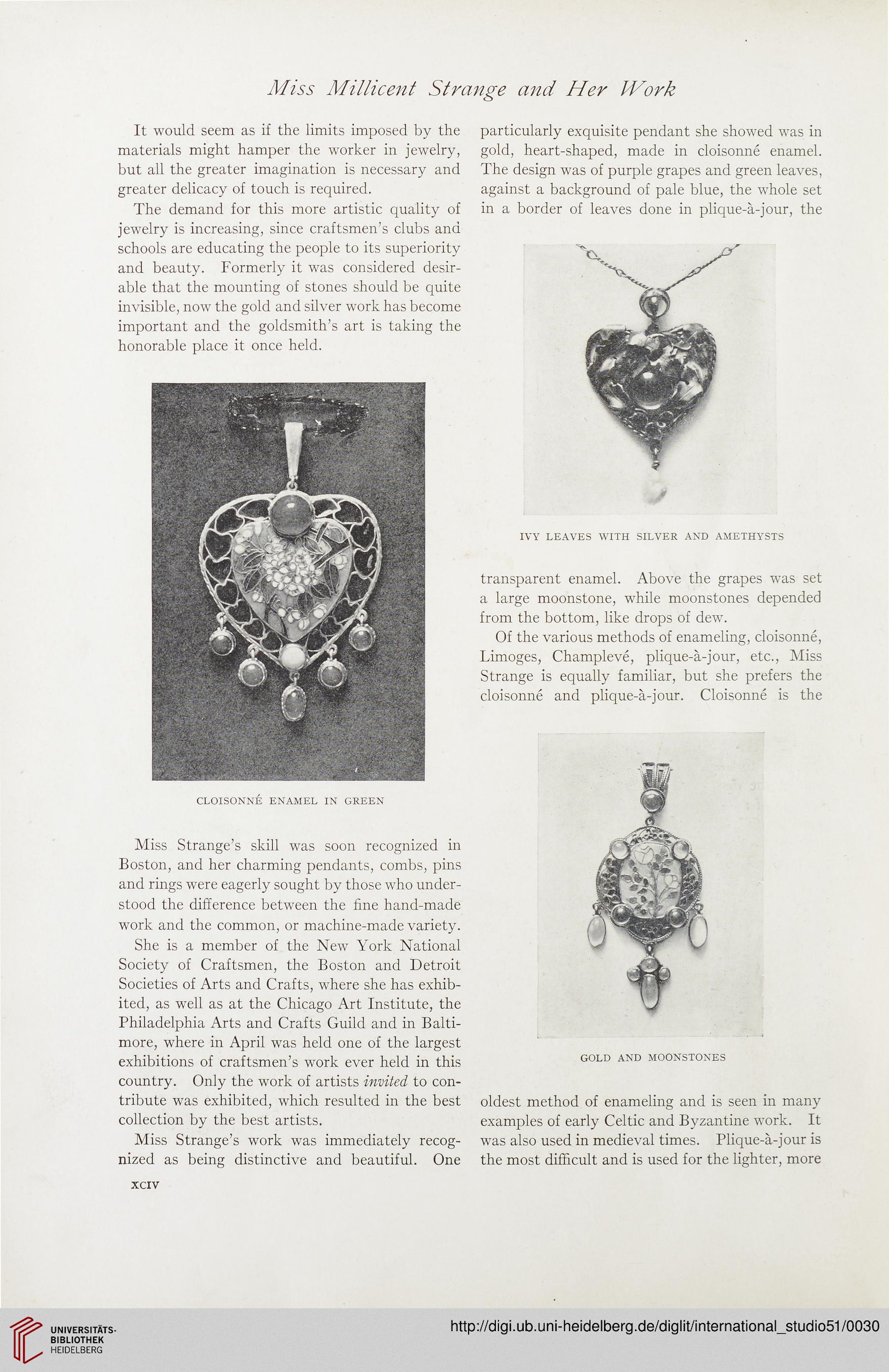Miss Millicent Strange and Her IMork
It would seem as if the limits imposed by the
materials might hamper the worker in jewelry,
but all the greater imagination is necessary and
greater delicacy of touch is required.
The demand for this more artistic quality of
jewelry is increasing, since craftsmen’s clubs and
schools are educating the people to its superiority
and beauty. Formerly it was considered desir-
able that the mounting of stones should be quite
invisible, now the gold and silver work has become
important and the goldsmith’s art is taking the
honorable place it once held.
CLOISONNE ENAMEL IN GREEN
Miss Strange’s skill was soon recognized in
Boston, and her charming pendants, combs, pins
and rings were eagerly sought by those who under-
stood the difference between the fine hand-made
work and the common, or machine-made variety.
She is a member of the New York National
Society of Craftsmen, the Boston and Detroit
Societies of Arts and Crafts, where she has exhib-
ited, as well as at the Chicago Art Institute, the
Philadelphia Arts and Crafts Guild and in Balti-
more, where in April was held one of the largest
exhibitions of craftsmen’s work ever held in this
country. Only the work of artists invited to con-
tribute was exhibited, which resulted in the best
collection by the best artists.
Miss Strange’s work was immediately recog-
nized as being distinctive and beautiful. One
particularly exquisite pendant she showed was in
gold, heart-shaped, made in cloisonne enamel.
The design was of purple grapes and green leaves,
against a background of pale blue, the whole set
in a border of leaves done in plique-a-jour, the
IVY LEAVES WITH SILVER AND AMETHYSTS
transparent enamel. Above the grapes was set
a large moonstone, while moonstones depended
from the bottom, like drops of dew.
Of the various methods of enameling, cloisonne,
Limoges, Champleve, plique-a-jour, etc., Miss
Strange is equally familiar, but she prefers the
cloisonne and plique-a-jour. Cloisonne is the
GOLD AND MOONSTONES
oldest method of enameling and is seen in many
examples of early Celtic and Byzantine work. It
was also used in medieval times. Plique-a-jour is
the most difficult and is used for the lighter, more
xciv
It would seem as if the limits imposed by the
materials might hamper the worker in jewelry,
but all the greater imagination is necessary and
greater delicacy of touch is required.
The demand for this more artistic quality of
jewelry is increasing, since craftsmen’s clubs and
schools are educating the people to its superiority
and beauty. Formerly it was considered desir-
able that the mounting of stones should be quite
invisible, now the gold and silver work has become
important and the goldsmith’s art is taking the
honorable place it once held.
CLOISONNE ENAMEL IN GREEN
Miss Strange’s skill was soon recognized in
Boston, and her charming pendants, combs, pins
and rings were eagerly sought by those who under-
stood the difference between the fine hand-made
work and the common, or machine-made variety.
She is a member of the New York National
Society of Craftsmen, the Boston and Detroit
Societies of Arts and Crafts, where she has exhib-
ited, as well as at the Chicago Art Institute, the
Philadelphia Arts and Crafts Guild and in Balti-
more, where in April was held one of the largest
exhibitions of craftsmen’s work ever held in this
country. Only the work of artists invited to con-
tribute was exhibited, which resulted in the best
collection by the best artists.
Miss Strange’s work was immediately recog-
nized as being distinctive and beautiful. One
particularly exquisite pendant she showed was in
gold, heart-shaped, made in cloisonne enamel.
The design was of purple grapes and green leaves,
against a background of pale blue, the whole set
in a border of leaves done in plique-a-jour, the
IVY LEAVES WITH SILVER AND AMETHYSTS
transparent enamel. Above the grapes was set
a large moonstone, while moonstones depended
from the bottom, like drops of dew.
Of the various methods of enameling, cloisonne,
Limoges, Champleve, plique-a-jour, etc., Miss
Strange is equally familiar, but she prefers the
cloisonne and plique-a-jour. Cloisonne is the
GOLD AND MOONSTONES
oldest method of enameling and is seen in many
examples of early Celtic and Byzantine work. It
was also used in medieval times. Plique-a-jour is
the most difficult and is used for the lighter, more
xciv




